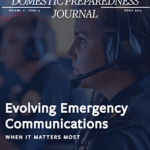The Emergency Department of any major hospital or other healthcare facility is commonly a site of workplace violence – with healthcare or mental health workers being the victims in 12 percent of the cases, according to a 2001 report issued by the U.S. Department of Justice. Long waits, substance abuse, the psychiatric aspects of illnesses or injuries – and/or, in some cases, easy access to weapons – are among the major contributors to the violence that has been reported.
Moreover, simply the threat of violence can create anxiety, fear, and decreased job satisfaction, according to a survey discussed earlier this year in the Journal of Academic Emergency Medicine. The potential threat of a terrorist attack against hospitals, coupled with the daily violence threat, increases the importance of an effective hospital-security program being developed and in place.
The evaluation process included site visits to each facility, meetings with various hospital personnel, and a comprehensive review of site plans, building plans, and security policies and procedures.
Most if not all hospital-security programs consist of three primary elements: facility architecture, security operations, and technical security measures, according to the “Summary Recommendations” on Hospital Security Best Practices released in September 2008 by the Arriba Corporation. A hospital-security program should maintain a balance between the three elements through effective planning and thoughtful execution. The successful program will recognize that the efforts of the security department must be complemented by support from the hospital’s other departments – e.g., the hospital administration, facility planning and engineering, and healthcare departments.
The Joint Commission – which accredits over 80 percent of the nation’s hospitals – has developed and published a number of recommendations in an attempt to help hospitals address the security issue. These requirements include but are not limited to: (a) the development and maintenance of a hospital Security Management Plan; (b) the scheduling and conduct of an annual risk assessment; (c) the implementation of various access-control and physical-protection measures; and (d) the development of an effective education and training program for hospital employees.
IAHSS Standards, an HHS Grant, and NCR Assessments
The International Association for Healthcare Security and Safety (IAHSS) also has published some helpful guidelines, which are followed by the directors of a number of healthcare facilities. The IAHSS standards address such important (but frequently overlooked) topics as hospital identification badges, the training of personnel, and record keeping.
In response to the growing threats of violence, coupled with the fear of a possible terrorist attack, hospitals in the District of Columbia recently completed a comprehensive security risk assessment. That assessment, carried out under a U.S. Department of Health and Human Services (HHS) Coalition Partnership Grant, analyzed the threat environment of twelve hospitals in the D.C. area and focused on security measures that support facility operations not only during daily operations but also in the aftermath of a major incident. The assessment was conducted by a highly respected security contractor over a six-month period of time. The evaluation process included site visits to each facility, meetings with various hospital personnel, and a comprehensive review of site plans, building plans, and security policies and procedures. Each facility received an individualized summary report identifying the facility’s principal risk concerns and specific corrective recommendations.
Also included as part of the grant deliverable were: (1) the publishing of a Hospital Security Best Practices Summary Recommendations document; and (2) a discussion of its contents – at a day-long Hospital Security Best Practices Forum attended by hospital security directors and local law-enforcement officials from throughout the National Capital Region.
Particularly prominent in the Best Practices Summary are recommendations to:
- Use perimeter fencing in high-crime-risk areas to deter and prevent unwanted access to the site (fence lines provide psychological as well as physical barriers);
- Use CPTED (Crime Prevention Through Environmental Design) concepts both to define the site and sense of place and to maintain clear lines of sight;
- Maintain exterior lighting levels that are in compliance with the levels recommended by IAHSS;
- Minimize the “secondary” use of fire and emergency exit doors for building access through policy enforcement, the monitoring of secondary doors through alarm and access-control systems, and guard-force patrols;
- Use vehicle access-control measures to limit passenger as well as truck access to the site – and, when and where possible, segregate both passenger and truck traffic;
- Use crash-rated drop-arm gates to control access to areas that enclose critical infrastructure facilities;
- Design bus routes and stops to minimize potential threats and ensure clear and unobstructed access to facility entrances (the traffic patterns for bus stops should allow for convenient pedestrian access but not be permitted to block building entrances; in addition, alternate bus circulation routes should be preplanned to accommodate measures instituted during critical-response situations);
- Establish a door, and door-hardware, maintenance program that includes frequent inspections, mandates the use of properly rated hardware in high-traffic areas, and requires the installation of door guards at loading docks and/or in areas where “push” vehicles or devices are used to move material; and
- Last, but of perhaps the greatest importance, design Emergency Department facilities to support security needs and operations.
Among the specific design measures emphasized are the building and designation of “holding rooms” for mentally ill or forensic patients, the provision of reasonable levels of protection for service counters, and the integration of strategically located guard posts within the Emergency Department. The design recommendations also include an important “Thou Shalt Not” mandate: Namely, do not collocate critical infrastructures such as oxygen plants and medical gas storage areas near emergency department entrances or decontamination areas.
To briefly summarize: Security has become increasingly important to the nation’s hospitals as they attempt to cope with the already large and still growing threats posed by workforce violence and potential acts of terrorism. The enhanced security efforts already adopted by many hospitals center on a broad spectrum of architectural, operational, and technical considerations – including, but not limited to, many of the specific design features mentioned above.
_______________
For additional information:
On the 2001 DOJ report, see Violence in the Workplace, 1993-99, by D.T. Duhart;
On the 2008 survey discussed in the Journal of Emergency Academic Medicine, see “A Survey of Workplace Violence Across 65 U.S. Emergency Departments (by S.M. Kansarga, S.R. Rao, A.F. Sullivan, J.A. Gordon, et al).

Craig DeAtley
Craig DeAtley, PA-C, is director of the Institute for Public Health Emergency Readiness at the Washington Hospital Center, the National Capital Region’s largest hospital. He also is the emergency manager for the National Rehabilitation Hospital, and co-executive director of the Center for HICS (Hospital Incident Command System) Education and Training. He previously served, for 28 years, as an associate professor of emergency medicine at The George Washington University. In addition, he has been both a volunteer paramedic with the Fairfax County (Virginia) Fire and Rescue Department and a member of the department’s Urban Search and Rescue Team. An Emergency Department PA at multiple facilities for over 40 years, he also has served, since 1991, as the assistant medical director for the Fairfax County Police Department.
- Craig DeAtleyhttps://domesticpreparedness.com/author/craig-deatley
- Craig DeAtleyhttps://domesticpreparedness.com/author/craig-deatley
- Craig DeAtleyhttps://domesticpreparedness.com/author/craig-deatley
- Craig DeAtleyhttps://domesticpreparedness.com/author/craig-deatley






